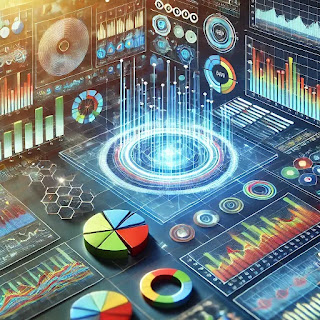Introduction: Data visualization is an essential aspect of data science, helping us transform complex datasets into easy-to-understand visuals. With the growing importance of data in decision-making, visualizing data in charts, graphs, and dashboards makes it more accessible to a wide audience. This post will explore the key role of data visualization, its applications, and why it is a powerful tool for anyone working with data.
1. What is Data Visualization?
Data visualization is the process of converting raw data into visual representations like charts, graphs, heat maps, and dashboards. These visuals allow people to quickly grasp trends, outliers, and patterns in data, helping decision-makers act on insights.
Types of Data Visualizations:
- Line Charts: Used to track changes over time.
- Bar Charts: Ideal for comparing different groups or categories.
- Pie Charts: Show parts of a whole.
- Heat Maps: Visualize data intensity or density across locations or metrics.
2. Why is Data Visualization Important?
In the age of Big Data, raw data alone can be overwhelming. Data visualization simplifies complex datasets, turning raw numbers into digestible visuals that anyone can understand. Whether it's business leaders, data scientists, or stakeholders, effective visuals can tell a story that drives decisions.
Key Benefits:
- Faster Understanding: Visuals allow users to absorb large amounts of data quickly.
- Better Decision-Making: Visualizing key metrics and trends helps identify opportunities and areas for improvement.
- Identifying Patterns: Complex relationships or trends in data are easier to spot through graphs and charts.
3. Applications of Data Visualization
Business Intelligence
In the business world, data visualization is crucial for monitoring performance metrics and tracking KPIs. Dashboards provide real-time insights into sales, marketing, and customer behavior, helping leaders make informed decisions.
Example:
- Tableau: Businesses use Tableau to create interactive dashboards that provide real-time insights on sales, revenue, and customer engagement.
Healthcare
In healthcare, data visualization helps doctors and researchers identify trends in patient data. Visual tools like heat maps and dashboards highlight the spread of diseases, patient outcomes, or medical research insights.
Example:
- COVID-19 Dashboards: During the pandemic, dashboards were used to visualize the spread of the virus, helping policymakers make timely decisions on lockdowns and health measures.
Finance
Financial analysts use data visualization to track market trends, portfolio performance, and identify investment opportunities. Complex financial models can be visualized to show potential risks and returns.
Example:
- Stock Market Visuals: Analysts use line charts and candlestick charts to visualize stock price movements and make predictions.
4. The Technology Behind Data Visualization
Several tools are available for creating beautiful, insightful visuals. Some popular platforms include:
- Tableau: Known for its ease of use and ability to handle large datasets, Tableau is widely used for business analytics and reporting.
- Power BI: A Microsoft tool that integrates seamlessly with other Microsoft products, making it popular for enterprise-level reporting.
- Matplotlib/Seaborn: Python libraries used by data scientists to create customized, detailed charts and graphs.
5. Challenges in Data Visualization
While data visualization is powerful, it comes with its own set of challenges:
- Overcomplicating the Visual: Too much information in one graph can confuse the audience.
- Misleading Visuals: Poorly designed visuals can distort the truth or mislead viewers.
- Data Accuracy: The integrity of the data is crucial—flawed data will result in flawed insights, no matter how appealing the visualization looks.
Conclusion:
Data visualization is the bridge between data and actionable insight. It turns overwhelming data into simple, intuitive visuals that guide decision-makers in industries ranging from healthcare to finance. As Big Data continues to grow, the ability to communicate insights through effective visuals will only become more critical. By making data easier to understand, data visualization empowers businesses and organizations to make smarter, faster decisions based on real-time information.

Comments
Post a Comment